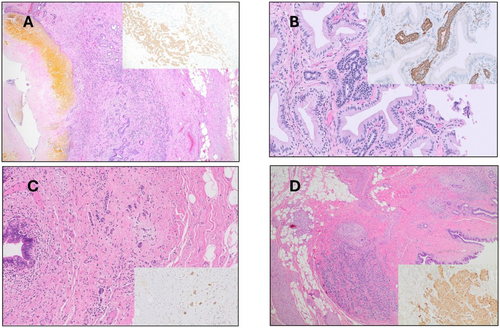Spectra of well-differentiated neuroendocrine lesions in the extrahepatic biliary system: a case series
Parts of this study were presented as a poster at the 2023 ASCP Annual Meeting.
Abstract
Aims
Neuroendocrine tumours (NETs) occurring in the extrahepatic biliary system are exceedingly rare. While NETs typically manifest as mass lesions, the occurrence of microscopic neuroendocrine cell proliferation without a distinct mass remains undocumented at this location. This study aims to characterise the clinicopathological features of a series of well-differentiated neuroendocrine lesions involving the extrahepatic biliary tree, including mass forming NETs and microscopic non-mass-forming neuroendocrine cell proliferation, designated neuroendocrine cell micronests (NCMs).
Methods and results
Surgical resections of NETs/NCMs involving the extrahepatic bile ducts and gallbladder were identified from electronic pathology databases among seven institutions spanning from January 2011 to September 2023. Clinical and histological findings were recorded. Ten patients (four female, six male: age range = 34–75 years) were included in the study. Histopathological examination revealed visible mass-forming lesions in four cases (1.6–14.0 cm in size), identified in the gallbladder (n = two) or extrahepatic bile duct (n = two), all diagnosed as well-differentiated NETs. The remaining six cases revealed incidental non-mass-forming NCMs in either the cystic duct (n = two), common bile duct (n = three) or gallbladder (n = one), ranging from < 0.1 to 0.4 cm; four were associated with biliary lithiasis. No evidence of metastasis or recurrence was seen in the follow-up period (range = 0.1–11.2 years).
Conclusions
This study highlights the spectrum of extrahepatic biliary well-differentiated neuroendocrine lesions, ranging from incidental microscopic NCMs to grossly apparent mass-forming NETs, potentially requiring different clinical management. Noteworthy is the frequent association of incidental microscopic neuroendocrine cell proliferations with biliary lithiasis, indicating a potential neuroendocrine metaplastic pathogenesis that merits further exploration.
Graphical Abstract
Conflicts of interest
The authors have no conflicts of interest and no funding disclosures.
Open Research
Data availability statement
The data that support the findings of this study are available from the corresponding author upon reasonable request.





